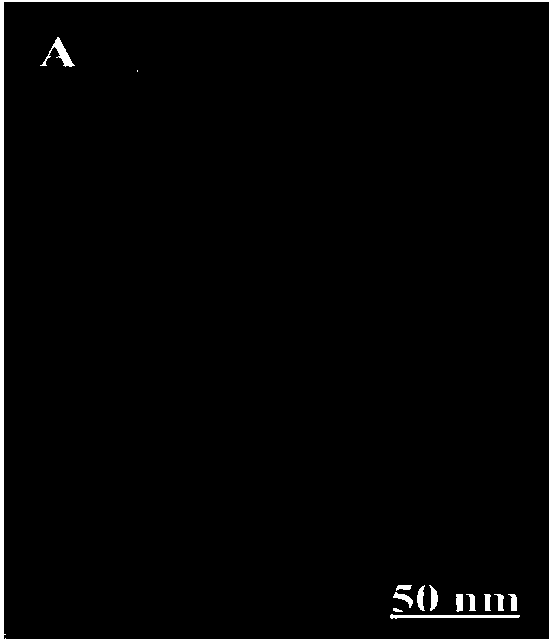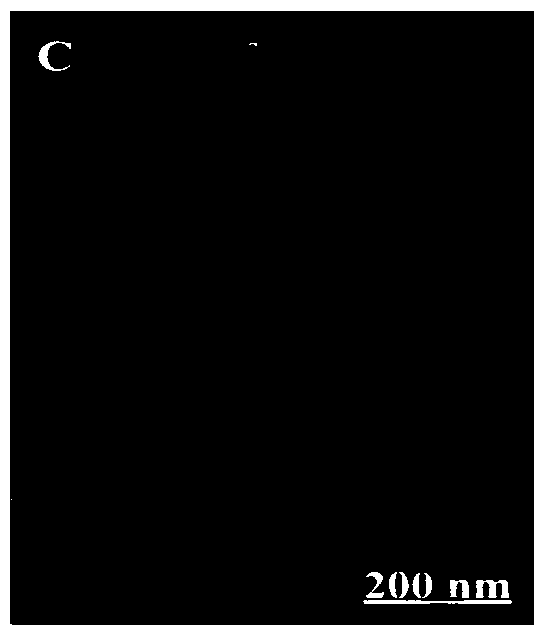Modified electrode for detecting pyrocatechol and hydroquinone and preparation method thereof
A technology of hydroquinone and modified electrodes, which is applied in the field of electrochemical detection, can solve the problems of complex operating conditions, low sensitivity, and time-consuming, and achieve the effects of easy preparation conditions, simple preparation methods, and high sensitivity
- Summary
- Abstract
- Description
- Claims
- Application Information
AI Technical Summary
Problems solved by technology
Method used
Image
Examples
Embodiment 1
[0037] Blend 1 mg of graphene (G) and 1 mg of carboxylated multi-walled carbon nanotubes (MWCNTs) in 1 mL of double-distilled water, ultrasonically disperse, add 0.01 mL of a 20% PDDA aqueous solution to the dispersion), and ultrasonically disperse A uniform black dispersion (PDDA / MWCNTs / G) was obtained; the glassy carbon electrode (GCE) was sequentially polished with metallographic sandpaper and aluminum oxide powder on suede until the GCE was polished to a mirror surface, and then the surface of the GCE was treated with twice distilled water Rinse, put the GCE after preliminary cleaning in double-distilled water, wash it in an ultrasonic cleaner for 20s, and dry it at room temperature for later use; 2 Drop-coated on the surface of GCE and dried at room temperature to prepare PDDA / MWCNTs / G modified glassy carbon electrode.
[0038] Wherein the preparation method of graphene is Hummers method; The preparation method of the carboxylated multi-walled carbon nanotube is: take the...
Embodiment 2
[0040] Blend 3mg G and 1mg MWCNTs in 2mL double distilled water, ultrasonically disperse, add 0.04mL PDDA aqueous solution with a mass concentration of 20% to the dispersion), and ultrasonically disperse to obtain a uniform black dispersion (PDDA / MWCNTs / G); Grind the glassy carbon electrode (GCE) sequentially with metallographic sandpaper and aluminum oxide powder on suede until the GCE is polished to a mirror surface, then rinse the surface of the GCE with secondary distilled water, and place the GCE after preliminary cleaning on the secondary surface. Wash in distilled water for 60s in an ultrasonic cleaner, dry at room temperature, and set aside; 2 Drop-coated on the surface of GCE and dried at room temperature to prepare PDDA / MWCNTs / G modified glassy carbon electrode.
[0041] The preparation method of graphene and carboxylated multi-walled carbon nanotubes is the same as in Example 1.
Embodiment 3
[0043] Blend 1mg G and 3mg MWCNTs in 2mL double distilled water, ultrasonically disperse, add 0.02mL PDDA aqueous solution with a mass concentration of 20% to the dispersion), and ultrasonically disperse to obtain a uniform black dispersion (PDDA / MWCNTs / G); Grind the glassy carbon electrode (GCE) sequentially with metallographic sandpaper and aluminum oxide powder on suede until the GCE is polished to a mirror surface, then rinse the surface of the GCE with secondary distilled water, and place the GCE after preliminary cleaning on the secondary surface. Wash in distilled water for 40s in an ultrasonic cleaner, dry at room temperature, and set aside; 2 Drop-coated on the surface of GCE and dried at room temperature to prepare PDDA / MWCNTs / G modified glassy carbon electrode.
[0044] The preparation method of graphene and carboxylated multi-walled carbon nanotubes is the same as in Example 1.
PUM
| Property | Measurement | Unit |
|---|---|---|
| length | aaaaa | aaaaa |
Abstract
Description
Claims
Application Information
 Login to View More
Login to View More - R&D
- Intellectual Property
- Life Sciences
- Materials
- Tech Scout
- Unparalleled Data Quality
- Higher Quality Content
- 60% Fewer Hallucinations
Browse by: Latest US Patents, China's latest patents, Technical Efficacy Thesaurus, Application Domain, Technology Topic, Popular Technical Reports.
© 2025 PatSnap. All rights reserved.Legal|Privacy policy|Modern Slavery Act Transparency Statement|Sitemap|About US| Contact US: help@patsnap.com



